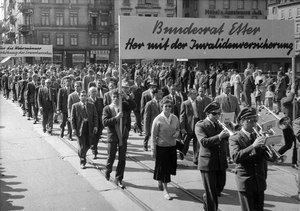
Unternavigation
Social Democratic Party
Social reforms have been at the heart of the Social Democratic Party’s (SP) manifesto since its inception in 1888. Over the course of the 20th century, the SP has transitioned from an opposition party to a governing party, charged with expanding and further developing social policy legislation.
The Swiss Social Democratic Party (SP) was founded in 1888. The party encompassed a number of smaller regional socialist parties and workers’ organisations. Class struggle and criticism of private property provided the core themes for the party’s manifesto of 1904 and set the SP apart from the bourgeois parties. In 1890, a social democrat was elected into the National Council for the first time. One year later, the party launched the popular initiative ‘Right to Work’. The wording of the initiative advocated the right to work or at least an unemployment compensation. However, the proposal was rejected at the ballot box in 1894. Its manifesto has committed the SP to the protection of workers in the event of unemployment, old age, disability, illness and maternity since 1904.
In 1918, the SP co-operated with the Swiss Federation of Trade Unions to establish the Olten Action Committee that called the general strike. The nine demands made by the action committee included the creation of an old age and disability insurance. In the wake of the general strike, the SP was able to better assert itself in the National Council thanks to the introduction of proportional representation; this led to their number of seats rising from 20 to 41 following the federal elections of 1919. Marxist arguments became increasingly controversial within the party and created the space for a more reformist policy orientation. In 1921, the most radical left-wing militants seceded from the party at the foundation of the Communist International and formed the Communist Party of Switzerland. The party’s claim to be part of the federal government became increasingly prominent. After obtaining 29 percent of the votes at the 1931 federal elections, the SP was the country’s strongest party. The social democrats were already represented in the administration of several major cities and now also held seats in several cantonal executives and parliaments. Following the strong election results of 1943, the social democrats obtained their first seat in the Federal Council with the election of Ernst Nobs. The SP were thus able to get involved in shaping and implementing federal policies in a majority-bourgeois government and parliament. The party’s share of votes at a federal level began to fall at the end of the 1960s, dropping to less than a fifth by 1987. The party had to cede its claim to being the country’s strongest party to the Swiss People’s Party (SVP) in 2003.
The crisis initiative co-launched by the SP in 1935 entitled ‘Popular Initiative for Combatting Economic Crisis and Plight’ and the ‘Popular Initiative for Economic Reforms and the Right to Work’ of 1947 proposed a number of economic and social reforms. In particular, they advocated the safeguarding of wage levels, job creation and unemployment compensation without challenging the capitalist system. This moderate reformist approach was enshrined in the SP manifesto in 1959 and subject to further debate after the social movements of the late 1970s criticised inequalities between social classes, sexes and nationalities. Within the party, there was a portion of members who tended to criticise the free market in addition to a moderate wing which represented the party majority.
In the 1960s, social democratic national councillors committed to introducing compulsory federal unemployment insurance. In doing so, they distanced themselves from some union leaders. The union leaders feared that these reforms would threaten the existence of union-based funds.
The social democratic federal councillor Hans Peter Tschudi served as the head of the Federal Department of Home Affairs from 1959 to 1973. AHV pensions were doubled as a result of swift action on the part of Tschudi, dubbed ‘Tschudi pace’. The introduction of supplementary AHV benefits in 1966 brought about improvement for persons receiving low pensions, while a general rise in AHV pensions was restricted. In opposition to his Federal Councillor, the SP launched the ‘People's Pension Initiative’ in 1969. In contrast to the Swiss Workers Party’s eponymous initiative, the social democrats sought to bolster the AHV without calling the role of private occupational provision into question. Indeed, trade unions close to the SP intended to play a key role in the management of pension funds assets. In 1972, the delegates’ assembly of the SP backed the three-pillar model and the introduction of compulsory admission to existing pension funds.
Since the 1970s and particularly since the 1990s, the SP has been adopting a more and more defensive role in social policy, while concentrating on opposing reform projects aimed at reducing the scope of social benefits.
In 2004, the SP participated in a campaign against the increase of women’s retirement age – a project that had been drawn up under the management of the first female SP federal councillor, Ruth Dreifuss from Geneva. However, she also advocated a demand heavily supported by committed feminists, namely to introduce a federal maternity insurance, as had been called for since the 1920s. This was adopted in 2004 after having been the main issue backed by feminist movements and militant trade unions for more than thirty years. Fundamental reform projects steered by social democratic federal councillors, such as the revision of disability insurance under Ruth Dreifuss’ tenure or the project for raising the retirement age returned to the agenda in 2012 under social democratic federal councillor Alain Berset, led to continuing debates and tensions within the SP.
Literatur / Bibliographie / Bibliografia / References: Jeanneret Pierre (2012), Deux siècles de luttes: une brève histoire du mouvement socialiste et ouvrier en Suisse, Genève; PSS (1988), Solidarité, débats, mouvement. Cent ans de Parti socialiste suisse, 1888-1988, Lausanne.
(12/2014)




